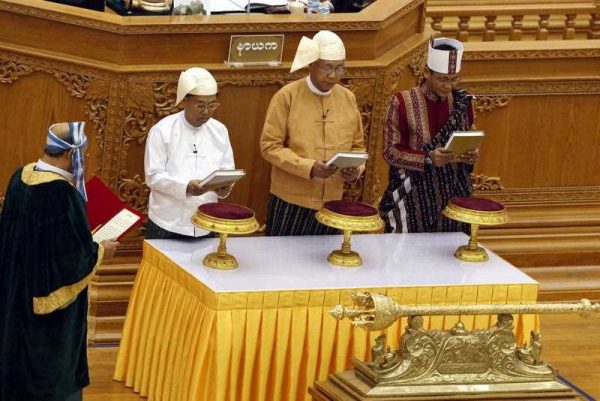On 15 March, a combined sitting of both houses of parliament elected the NLD nominee Htin Kyaw as the next president, with ethnic Chin NLD parliamentarian Henry Van Thio and military nominee Lieutenant General Myint Shwe as vice presidents. An economist by training, Htin Kyaw was formerly a civil servant and academic and is a trusted associate of Aung San Suu Kyi. While he is expected to carry out faithfully the wishes of Aung San Suu Kyi and the NLD, Htin Kyaw is himself widely respected as a man of integrity. He should not be seen simply as a ‘proxy’ for Suu Kyi. Although playing a largely ceremonial role, he is likely to exercise an invaluable steadying influence over the government.
The new government structure, approved on 22 March, comprises only 18 ministers and 21 ministries compared to the outgoing government’s unwieldly 36 ministries and even more ministers. Most of the mergers proposed are obvious and logical, reflecting the new government’s stated aims of administrative efficiency and achieving savings for allocation to programs.
Aung San Suu Kyi herself will be directly involved in the day-to-day management of the government as Foreign Minister, Energy Minister and Education Minister. This means that she will be an integral part of the government. In accordance with the constitution, she will be less involved in NLD party affairs. But party leadership at the moment looks to be in very robust condition, with a number of effective and experienced senior representatives in place. As Foreign Minister, Suu Kyi will become a member of the top decision-making body under Myanmar’s constitution, the National Defence and Security Council.
A Ministry of Ethnic Affairs will be set up for the first time, giving effect to the NLD’s goal of making peace its highest priority. The new ministry will encourage high expectations on the part of ethnic communities, whose interests can hardly be said to have been given top priority in the past. But real progress for ethnic communities will require enormous efforts and innovative approaches, as well as better collaboration and more mutual goodwill than we have seen so far.
The minister designate is the Mon National Party’s deputy chair, Nai Thet Lwin, a powerful leader in the Mon community from a wealthy business family who has a reputation for getting things done. One of his major tasks will be to expedite new arrangements for ceasefire and peace negotiations following the replacement of the Thein Sein government’s internationally-supported Myanmar Peace Centre with two NGOs.
Only one change seems slightly odd: the combination of the labour and immigration ministries. For many years in Myanmar the immigration authorities essentially performed a law enforcement role and were somewhat repressive. There are certainly some synergies between labour and immigration, but under the Thein Sein government the labour and social welfare ministries were merged. This had the superficial benefit of ensuring labour programs had a welfare impact. Without knowing how much success this achieved, it seems somewhat strange that a government with a socially progressive agenda would move in a different direction on labour welfare.
Aung San Suu Kyi herself at one point indicated her intention to form a ‘reconciliation’ government. In this spirit, two unexpected nominations for cabinet are former senior executive members from the defeated former government party Union Solidarity and Development Party, Thein Swe and Thura Aung Ko. How their roles will be played out in the new government remains to be seen. In Myanmar’s annual armed forces day parade in Naypyitaw on 27 March, the military’s commander-in-chief, Senior General Min Aung Hlaing, said the army would continue to cooperate in Myanmar’s transition to democracy.
Recent negotiations have also dealt with the appointment of chief ministers of the new state and region governments, which could be substantially more important in the future if power and resources are really devolved to the states. NLD representatives were nominated to all chief minister positions, even though the NLD did not win a majority in all states and regions. The NLD’s role in these regional assemblies may continue to prove a considerable challenge as it comes to depend more on local leaders to serve local interests, and as it is obliged to develop more locally distinctive policies reflecting different local circumstances.
What remains unknown is how the new government will work in practice. How will NLD–Army cooperation operate, given that nobody in Myanmar has any experience of power sharing of this kind since the 1960s? What factors will come into play if the cabinet disagrees over policy directions? What will happen if there is a national security crisis of some kind — whether it is a resurgence of communal violence, an eruption of one of the ongoing insurgencies, or something new? Will personal political relationships function to strengthen or weaken the government?
Other important issues relate to how the NLD government will address the major challenges that lie ahead. How will the federalist desires of the states and regions be dealt with? How will tensions be reduced between different communities? And how will the gap between Myanmar’s socioeconomic development and that of its ASEAN partners be narrowed? A largely benign international environment for Myanmar can probably be assumed, but will this continue? The cabinet may have been announced, but the direction of Myanmar’s future is still to be defined.
Trevor Wilson is Visiting Fellow at the Department of Political and Social Change, Australian National University and a former Australian ambassador to Myanmar.


Thanks for a thorough summary of the multitude of the complex unanswered questions facing the new government in Myanmar. I look forward to follow up articles which will update us on how things are going there.